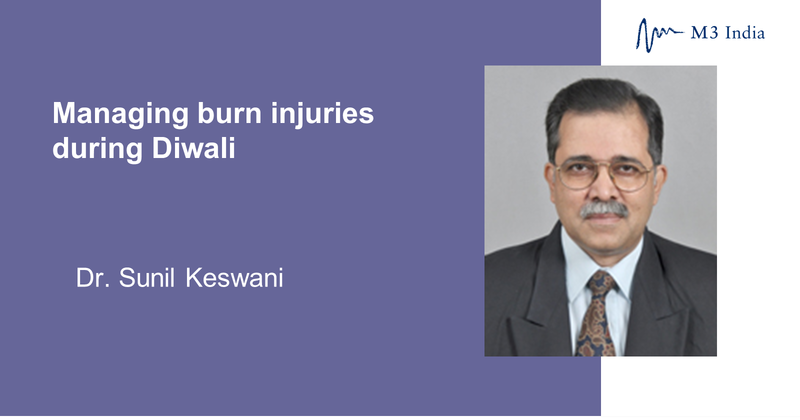Managing burn injuries during Diwali: Dr. Sunil Keswani
M3 India Newsdesk Nov 15, 2020
Dr. Sunil Keswani, an acclaimed Cosmetic Surgeon provides the treatment protocol and clinical management tips for treating burn injuries, commonly reported during Diwali.

Diwali, a religious and cultural festival celebrated all over India as well as outside the country has people lighting earthen lamps and bursting firecrackers. But, there are also many burn injuries reported during this season, especially during the first 3 days of the festival.
Research studies have shown that 70% burns in the age group of 10 to 15 is from firecrackers (64% are from flowerpots, 13% from bombs, and 9% from chakras). Flowerpots, bombs, and chakras are the main causative agents of firecracker burns in India.
The hands, face, and eyes are more commonly affected body parts during such accidents. Careless lighting of crackers during Diwali or lighting crackers as part of a competition among children often leads to these mishaps. Lack of adult supervision, use of synthetic clothing and flammable flowing fabrics add to the problem.
Flame burns and treatment
In flame burn wounds, subjective and objective evaluation is needed.
- Subjective evaluation of burn wound is based on the external features of the wound such as wound appearance, capillary refill, and burn wound sensibility to touch and pinprick
- Objective evaluation is based on the base of the wound site, size and depth, and age of the patient
Most of Diwali burns are minor- less than 10%.
Wound assessment and treatment
The wound site is assessed based on the anatomical part that is affected.
- Size of the burn is usually represented as a percentage of total body surface area (%TBSA) by using Wallace rule of nines, Lund and Browder chart, and the rule of palm
- Depth of the burn wound is measured from the visible area to the deepest area
Wound depth is categorised as follows:
- Epidermal
- Superficial Dermal- usually pink, moist, blistered, blanch on pressure and are very painful
- Mid-Dermal- difficult to assess on the first look, but after 10-14 days the wounds reveal their true depth (second look)
- Deep Dermal- wound is dry and pearly (waxy) and white in color
- Full-thickness- visible thrombosed capillaries, venules, or other blood vessels, leathery in appearance, painless, leads to loss of hair follicles, sebaceous and sweat glands
Blister Management
- Small blisters (<5 cm) can be left in situ to act as a biological dressing
- Large blisters (>5cm) should be ruptured if it is in an odd part (over joints) or if they produce functional impairment at the time of initial dressing
Assessing degree of burns
There are three types or levels of burns:
- First degree:
- It involves only the epidermis and this can be treated by antibacterial cream
- It heals spontaneously in 7 days
- Second degree: A second-degree burn involves the whole epidermis and varying depth of dermis and is classified into superficial and deep burn
- Second-degree superficial burn can be treated by regular dressing with antibacterial cream under aseptic precautions and it heals spontaneously in 7 to 14 days
- Second-degree deep burn requires surgical intervention in the form of early skin excision and grafting with autograft or homograft
- Third-degree: It does not heal spontaneously and requires surgical intervention
Acute burn management protocol
First aid
- Water should be poured on burn wounds for 3 to 4 hours or till the burning sensation subsides, but ice-cold water is not recommended on burn wounds because it can be dangerous
- In case water is not available, the patient should be wrapped in a clean thick blanket or cloth and the victim should be made to rest on the floor
Treatment according to the anatomical part
Face, eyes and hand burns are more commonly reported during Diwali.
- Eye burns:
- Ophthalmic opinion is required to rule out corneal injury and per orbital oedema
- Treatment involves irrigation with copious normal saline and maintenance of adequate lubrication by use of antibiotic drops or ointment
- Face burns: Lips and mouth burn wounds should be treated with local application of lubricant cream or ointment to prevent cracking and bleeding
- Hand burns:
- Wound should be treated with close sterile dressing using Soframycin cream and dressing needs to be changed every alternate day
- Kollagen-M dressing should be done for superficial burns
- Hands and feet should be elevated, especially if the wounds are in the extremities
- The patient should be advised complete bed rest
- Oral antibiotics, anti-inflammatory, and analgesic drugs should be prescribed for healing
- To prevent functional deformities, physical rehabilitation (physiotherapy) should be advised for 15 days after complete wound healing
This article was originally published on November 6, 2018.
Disclaimer- The views and opinions expressed in this article are those of the author's and do not necessarily reflect the official policy or position of M3 India.
-
Exclusive Write-ups & Webinars by KOLs
-
Daily Quiz by specialty
-
Paid Market Research Surveys
-
Case discussions, News & Journals' summaries